BACTERIA AND FUNGI, AND GRAPES, OH MY
/7 Comments/in Fruit, Gardening, Pests/by Lee ReichUpcoming Fall Fruit Workshop
See web page https://leereich.com/workshops for details.
The River Runs Green
Crossing the bridge over the Wallkill River on my way home, I glance to my right to admire the river itself. What a beautiful color it has turned, a bright turquoise. Ponds I pass also have taken on this bright complexion, for which we can thank, or curse, organisms known as blue-green algae (heretofore referred to as BGA).
Algae, they are not, though. BGA are bacteria known as cyanobacteria. “Algae” generally refers to eukaryotes, organisms with distinct nucleii and specialized organelles. BGA are prokaryotes, lacking such features.
BGA can be toxic, which is good reason to curse them. Drinking or swimming in contaminated waters can cause problems to humans and other animals, including dogs, who seem to be otherwise able to drink almost any water without ill effect. The “cyan” in the name and the criminal cyanotoxins are not at all related to cyanide. The name come from “cyan,” which is the color blue-green.
Many kinds of BGA are found throughout the world, often in extreme conditions. Not all produce cyanotoxins; some produce them only under certain conditions. Not all are even blue-green; the Red Sea gets its color from Trichodesmium erythraeum, a species of BGA. Certain conditions cause “blooms,” such as those I was admiring in the river and ponds. Here, it’s probably a combination of relatively dry conditions resulting in shallow and calm waters along with the usual influx of nutrients, mostly phosphorus and mostly from farms, septic systems, and lawns.
BGA are photosynthetic organisms, just like plants, imbibing carbon dioxide during the day and spewing out oxygen. These primitive organisms, “in the beginning,” were important for oxygenizing the Earth’s atmosphere, thus stimulating biodiversity. We could praise them for sequestering carbon.
Agriculturally, some cyanobacteria are important because they can convert atmospheric nitrogen into forms of nitrogen that plants can use. Although these cyanobacteria are especially important for maintaining fertility of rice paddies, they are present, to some degree, in virtually all soils. Some research even points to benefits of inoculating soils with these organisms.
Bags vs. Fungi
So now I’m home, my head out of the soil, and admiring my grape vines. The dry weather has been almost as good for the grapes as it has been for the cyanobacteria. Dry weather minimizes grape diseases and abundant sunlight puts flavor and sweetness into the berries. With annual applications of mulch around the grapes and their far reaching roots, I never worry about my established vines being thirsty.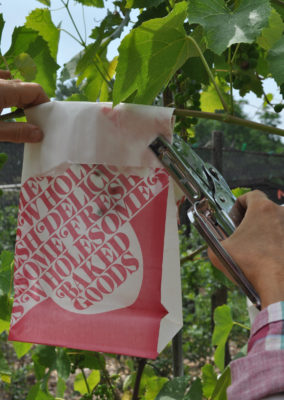
Back in early summer, we went to the trouble of affixing paper “delicatessen” bags around 100 bunches. Now is the payoff. Peeling back the paper usually reveals perfect, full, bloom-dusted bunches of especially delectable grapes. “Especially delectable” because I can let these protected bunches hang longer on the vines than unbagged bunches, which do have some disease and are prey to bees, wasps, and birds. These bagged grapes get dead ripe before being harvested.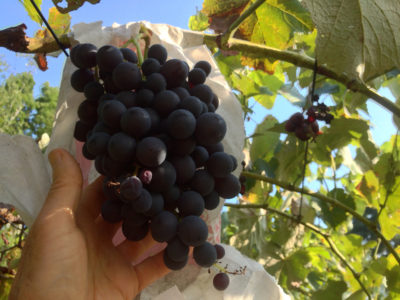
The bagging isn’t really all that troublesome. We just select downward hanging bunches, made easier because I train fruiting canes horizontally across a 5-wire, flat trellis, and remove any tendrils or leaves opposite the bunches. After making a slit down each side of a bag, the slitted opening is slid up the cane on either side of the bunch, the top of the bag is folded over, and then the flap stapled down on either side — well worth the minute or so it takes from selection to finish bagging a bunch.
Grapes to Keep
With many varieties of established grapevines, I can cut down any whose flavor is not up to snuff or that don’t produce well without having to bemoan waiting for new ones to start bearing. The “keepers” tide me over. Variety choice is somewhat limited here because of winter cold and because cooler, damp air collects in this valley, promoting disease, abetted by inoculum from all the wild grape vines grappling high into neighboring trees along the forest edge.
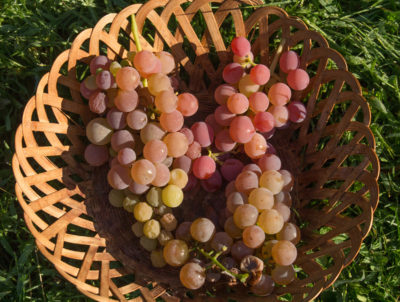
Glenora and Vanessa seedless grapes
I’ll be doing a Henry IVth on Mars and Concord.
Some of my current favorite varieties are Vanessa, Somerset Seedless, and Glenora, all seedless varieties. Of the three, Glenora has the best flavor, Vanessa the best texture, but they’re all very good. Some of my favorite seeded varieties are Alden, whose corpulent berries hang in large bunches, and Brianna, which isn’t quite ripe yet, but every year has rewarded us with foxy-flavored, pale green berries.
Still to come for this season are Edelweiss, which has a rich, very foxy flavor but has not been very productive the last few years, and Brianna, with its own rich flavor not so dependent on foxiness.
A few more years of tasting and watching will dictate whether New York Muscat, Cayuga White, Bertille Seyve 2758, Lorelei, Reliance, Swenson White, and Wapanuka keep their home here. They’re all good grapes, but why grow good grapes when I could grow great grapes from among the 5,000 or so varieties (not all adaptable here, of course)?
(That “foxy” flavor I kept referring to is characteristic of many American grapes, and is typified by the variety Concord. No one is sure how “foxy came to describe that flavor.)
DRY WOOD, & AUTUMNAL AIR
/3 Comments/in Design, Flowers, Gardening, Planning, Soil, Vegetables/by Lee ReichPassionflower to the Rescue
When I began, many years ago, to heat my home with wood, I struggled to get the driest possible wood, finally building a 60-foot long woodshed beneath which a double row of logs basked in the direct hit of sunlight from the south. I more recently learned that firewood can be too dry, which is when moisture drops below 15 to 20 percent. Bone dry wood can’t get enough oxygen for a clean, efficient burn, so smoke, within which is locked the potential for rendering additional heat, is produced; pump enough oxygen into the mix, though, and you get an inferno that can damage a woodstove.
So — and here’s the plant-related part — rather than tear down or put siding on my super-drying woodshed, I put some heat loving vines to climb and provide some shade on the south face. Sections of hog-fencing temporarily hung on hooks just below the roof in front of each of the 8 foot bays support the vines.
Maypop, Passiflora incarnata, is an ideal candidate for this location. (Learn more about maypop — a whole chapter’s worth! — Uncommon Fruits For Every Garden.) It’s an herbaceous perennial, emerging early each June to grow vigorously into lanky vines 10 or more feet long. Maypop is a hardy species of passionflower, and a few weeks after emerging, the intricate blue or white blossoms unfold along the stems.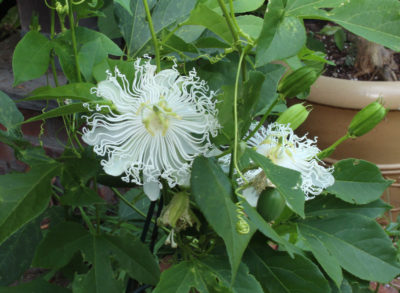
Flowers would be enough, but there’s more. A few weeks later, those flowers morph into egg-shaped fruits: tropical passionfruits this far north.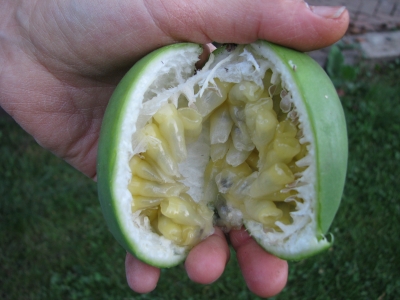
In southeastern U.S., maypop, with its spreading root system, is considered a weed. This far north, maypop will enjoy the extra heat of the microclimate at the south face of the woodshed. The woodshed itself will contain the plant in its travel northward. The lawnmower will contain the plant in is travel southward. Let it spread all it wants east and west along the base of the shed.
Morning Glory & Kin for Quicker Effect
In spring I planted a maypop plant at the foot of four of the woodshed bays. As a perennial, maypop needs time to get established. Because I went to the trouble of hanging a trellis from each of the bays, I wanted something to clothe even this summer.
Enter the Convolvulaceae family, which counts morning glory among its kin. Less know, but also kin and vines with pretty flowers, are cardinal vine and moonflower. I figured that some member of this family could accompany maypop in each planting hole.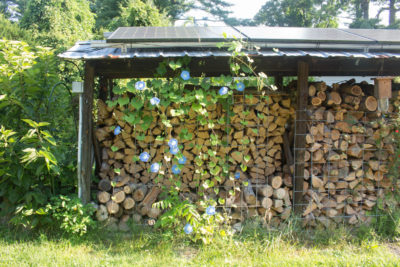
All three Convolvulaceae family members grow vigorously so could provide good coverage for the woodshed. They also integrate well with each other, design-wise. Morning glory wakes up early, its sky-blue flowers opening each morning to foreshadow the blue sky that lies ahead. (The flowers remain furled under overcast skies.) Once the sun rises high in the sky, fire-engine red flowers of cardinal flower take the torch for the remainder of the day. As night falls, moonflowers’ large, white trumpets open and emit their sweet scent.
This year, those annual vines grew so vigorously that they stunted their companion maypops. Next year will be better. Also, a couple of plants of another vine, native and somewhat decorative, have tried to get a foothold in the planting. Poison ivy, you’re not welcome here.
Autumnal Readiness
Morning glories have started lingering later into the mornings, a sign that autumn is approaching. I’m also getting signals — a softness in the air and an occasional chill, a slight chill — of autumn’s approach. Those signals do not have me lingering late in the morning, though.
The imminence of autumn has me scurrying around making sure all is copacetic in the weeks to come and on into next year. Turnips and winter radishes have been thinned. Cabbages, Chinese and European, transplants are growing well, hinting at crocks of kim-chi and sauerkraut to come. Onions have been harvested and woven into ropes for storage, now in the garage, later in the basement.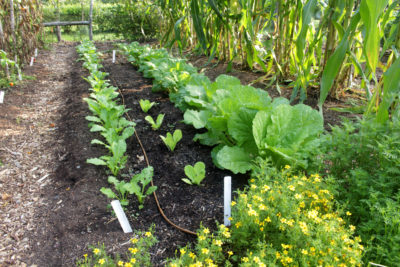
Any cleared vegetable bed is given a thorough weeding and then an icing of an inch depth of compost. That compost will snuff out small weeds attempting to sprout below. Additionally, it will feed soil microbes which will, in turn, feed plants for at least a year. I’ll sow arugula, mustard greens, and “spring” radishes in the bed which I recently cleared of sweet corn, weeded, and composted.
A couple of sites have been prepared for two new trees. “Prepared” is too fancy a word; all I did was pile mulch on the ground at both locations. The mulch will kill existing vegetation and leave soft, moist ground for easy planting in October.
Autumn will be bountiful and next year will be a good year.
UNPERMACULTURE
/0 Comments/in Design, Fruit, Gardening, Pests, Soil, Vegetables/by Lee ReichAccusations, (Mostly) not True
I’ve understandably been accused of being a “permie,” that is, of practicing permaculture.
(In the words of permaculture founder, Bill Mollison, “Permaculture is about designing sustainable human settlements. It is a philosophy and an approach to land use which weaves together microclimate, annual and perennial plants, animals, soils, water management, and human needs into intricately connected, productive communities.” In the words of www.dictionary.com, permaculture is “a system of cultivation intended to maintain permanent agriculture or horticulture by relying on renewable resources and a self-sustaining ecosystem.”)
Walk around my farmden and, yes, you’ll come upon Nanking cherry bushes where forsythia bushes once lined the driveway, an American persimmon tree where a lilac bush once stood, and other edible plants used also for landscaping. In the vegetable garden, I preserve soil integrity by never tilling it, and, in the south field, blackcurrant bushes make use of the space beneath pawpaw trees. There’s the requisite mushroom yard of shiitake-inoculated logs, free-range poultry, solar panels, a rain barrel . . .

Pawpaws interplanted with blackcurrants, and a row of hardy kiwis
But no! I am not a permie. My vegetables grow in beds in parallel, straight rows (rather than keyhole plantings) and, despite that commingling of blackcurrants and pawpaws, most trees, shrubs, and vines here keep to themselves. Permaculture plantings of, say, hazelnuts in tall grass and rubbing elbows with elderberries, seaberries, apples, pears, and other edibles become, over time, an unproductive management nightmare with some plants drowning out others, productivity declining due to shade, and diseases increasing from tangled stems creating dank conditions. The paltry output of such planting are best left for wildlife, who can afford to spend all day foraging for a few tidbits of food.
My hazelnuts are grown in a mown strip that, for easy gathering, is sheared low as nuts ripen.
Low maintenance is a goal touted by permaculturalists; understandably so. But taken to the extreme, low maintenance means not giving the grape vine the pruning it needs to be a healthy vine yielding the most flavorful berries that are easy to harvest. (One book suggests, rather than troubling with a trellis, growing grape vines up trees; the vines do so in the wild, but such fruit, in partial shade and not easily accessible, can never be high quality.)
Much of permaculture seems to me to be not only unrealistic, but also no fun. I enjoy caring for my plants, reaping the gustatory and other rewards for a job well done. I like the challenge of researching some pest or nutritional problem and finding a solution. I like watching how plants respond to my ministrations, whether I’m wielding pruning shears, a pitchfork piled high with compost, or my winged weeder hoe.
Agriculture is about balancing Nature’s designs and human will. Too much of the latter is a losing battle. Too much of the former leaves nothing worth harvesting.
Big Bantam, an Oymoron
My planting of sweet corn is very un-permaculture. It’s high-culture: 6 seeds per hill dropped into compost-enriched ground maintained weed-free, timely watering with drip irrigation, hills thinned to 3 stalks per hill, even stakes to keep the stalks standing soldier straight. I mentioned, last week, how my Golden Bantam variety of sweet corn isn’t bantam at all. The stalks soar over 10 feet high.
Was it because of my green thumb? No. I now know that it is genetics.
This year I made four plantings of Golden Bantam. The two later plantings are, in fact, bantam-size. Looking over my seed orders, I see that I had planted Golden Bantam Corn, Original 8-row Golden Bantam Corn, and Improved Golden Bantam Corn.
Golden Bantam is an open-pollinated variety. As with any open-pollinated variety, various strains might arise, strains which might differ in some ways from the original. With any good variety, the hope is that progeny are monitored to eliminate any off-type varieties — or to look for something that might be better than the original.

Golden Bantams compared
So the name Golden Bantam could be attached to the original Golden Bantam, from 1902, or any strain, which could also have “Improved,” “Original,” etc. attached its name. (Golden Bantam was also developed into a hybrid, Golden Cross Bantam, which, like other hybrids, would be genetically more consistent and ripen in a shorter window of time.)
On the theory that bigger is better, “Improved” was tacked onto name of the strain of my early plantings. The original Golden Bantam was 8-row; Improved Golden Bantam is 10 to 14 row. I should have read the catalog more closely because Improved Golden Bantam casts too much shade, ripens too late for my intensively planted vegetables, and yields less, with but a single ear per stalk. The original also has better flavor, to me.
Permaculture, but not by Me
Walking down the main path of my vegetable garden yesterday, you’d come upon a very permaculturalesque planting — in the path. The path was overrun with purslane, which I didn’t even have to plant. Purslane is a tasty, very nutritious vegetable enjoyed raw or cooked. But not by me.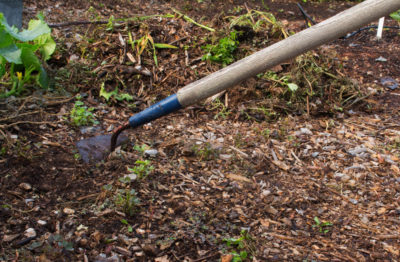
I grabbed my winged weeder and hoed the purslane loose from the soil. As a succulent, purslane can continue to grow — and seed! — even with its roots flailing in the air. So after hoeing, I scooped the plants up to feed to the compost file.

